Elsevier Encyclopedia of Geology - vol I A-E
Подождите немного. Документ загружается.

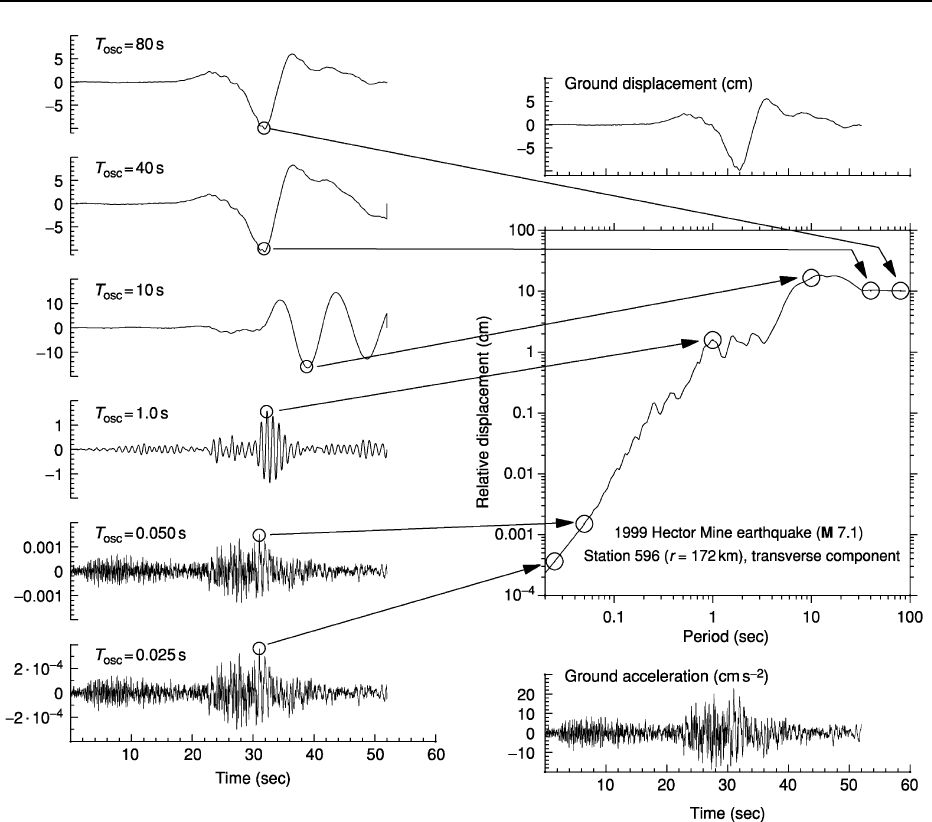
divided by 10. The acceleration response spectrum
intersects the vertical axis at PGA (Figure 8). PGA
as a ground-motion parameter has many shortcom-
ings, including a very poor correlation with structural
damage, but one of the main reasons that it is persist-
ently used is the fact that it essentially defines the
anchor point for the acceleration response spectrum.
The relationship between the natural period of vibra-
tion of the building and the frequency content of
the ground motion is a critical factor in determining
the impact of earthquake shaking on buildings.
In recent years, there has been a gradual tendency
to move away from the use of acceleration res-
ponse spectra in force-based seismic design towards
displacement-based approaches, because structural
damage is much more closely related to displacements
than to the forces that are imposed on buildings very
briefly during ground shaking. Techniques for assess-
ing the seismic capacity of existing buildings have
already adopted displacement-based approaches,
giving rise to greater interest in displacement response
spectra (Figure 9).
Prediction of Earthquake
Ground Motion
Recordings of ground motions in previous earth-
quakes are used to derive empirical equations
that may be used to estimate values of particular
ground-motion parameters for future earthquake
Figure 7 Illustration of the concept of the response spectrum. The trace in the lower right-hand corner is the ground acceleration,
and the traces on the left-hand side are the displacement response time-series for simple oscillators with different natural periods of
vibration (T
osc
). The maximum displacement of each oscillator is plotted against its natural period to construct the response spectrum
of relative displacement. The lowest two traces in the figure illustrate that for short-period oscillators, the response mimics the ground
acceleration, whereas for long-period oscillators, the response imitates the ground displacement (shown in the upper right-hand
corner). M, Moment magnitude; r, distance to fault rupture.
506 ENGINEERING GEOLOGY/Seismology
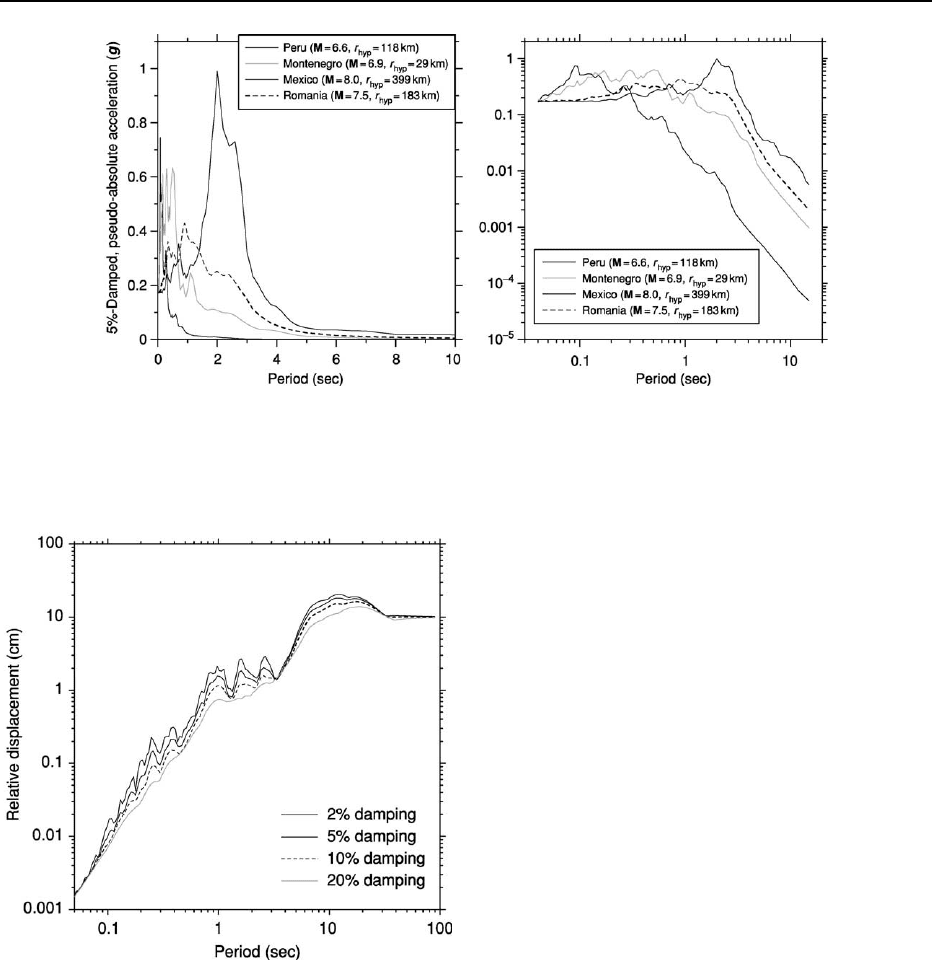
scenarios. Such empirical equations have been de-
rived for a variety of parameters, but the most abun-
dant are those for predicting PGA and ordinates of
response spectra. The equations are often referred to
as attenuation relationships, but this is a misnomer
because the equations describe both the attenuation
(decay) of the amplitudes with distance from the
earthquake source and the scaling (increase) of the
amplitudes with earthquake magnitude. These two
parameters, earthquake magnitude and source-to-site
distance, are always included in ground-motion pre-
diction equations (Figure 10). The equations are
simple models for a very complex phenomenon and
as such there is generally a large amount of scatter
about the fitted curve (Figure 11). The residuals of the
logarithmic values of the observed data points are
generally found to follow a normal or Gaussian dis-
tribution about the mean, and hence the scatter can
be measured by the standard deviation. Predictions
of PGA at the 84-percentile level (i.e., one standard
deviation above the mean value) will generally be as
much as 80% higher than the median predictions
(Figure 12).
The nature of the surface geology can also exert a
pronounced effect on the recorded ground motion.
The presence of soft soil deposits of more than a few
metres thickness will tend to amplify the ground
motion as the waves propagate from the stiffer
materials below to the surface (Figures 2B and 13).
To account for this effect, site classification is gener-
ally included as a third explanatory variable in pre-
diction equations for response spectrum ordinates,
allowing spectra to be predicted for different sites
(Figure 14). The modelling of site amplification
effects in ground-motion prediction equations is
generally crude, using simple site classification
schemes based on the average shear-wave velocity of
the upper 30 m at the site and assuming that the
degree of amplification is independent of the ampli-
tude of the input motion, whereas it is generally ob-
served that weak motion is amplified more than
strong motion; this non-linear response of soils is
reflected only in a few predictive equations. For this
Figure 8 Acceleration response spectra (5% damped) of the four accelerograms shown in Figure 5; the plots are identical except
that the one on the left uses linear axes and the one on the right uses logarithmic axes. Each type of presentation is useful for viewing
particular aspects of the motion, depending on whether the interest is primarily at short or long periods of response. M, Moment
magnitude;
r
hyp
, distance from the hypocentre.
Figure 9 Displacement response spectra of a single accelero-
gram from the 1999 California Hector Mine earthquake (moment
magnitude 7.1; station 596;
r = 172 km, r is the distance from the
fault rupture in km, transverse component), plotted for different
levels of damping . The spectra all converge to the value of peak
ground displacement at very long periods.
ENGINEERING GEOLOGY/Seismology 507
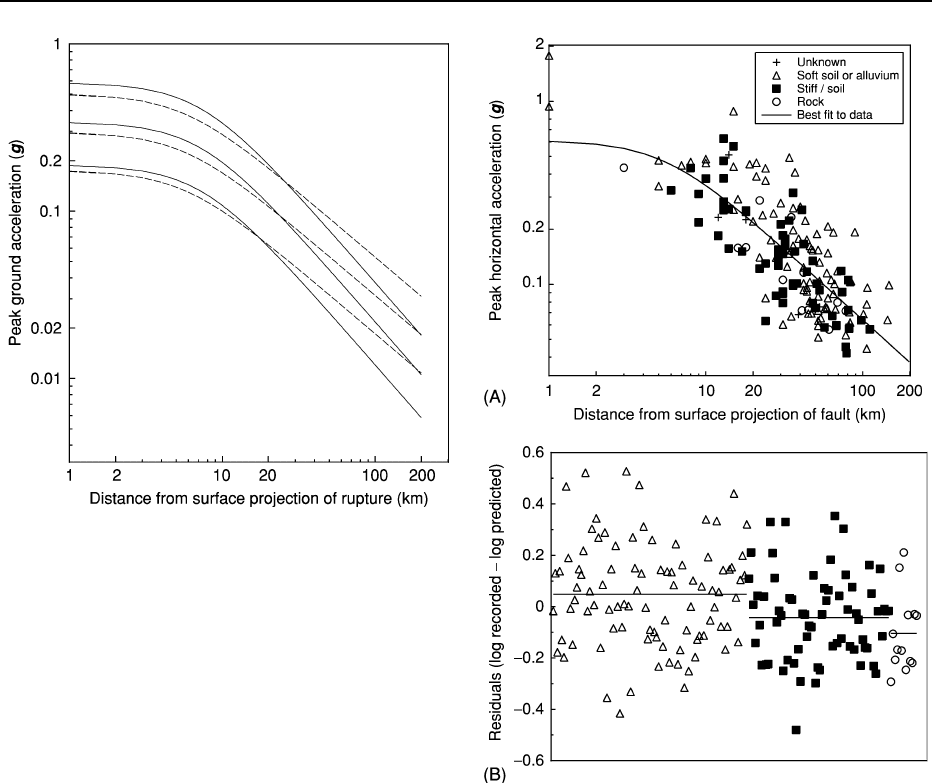
Figure 10 Predicted median values of peak ground acceler-
ation as a function of distance for earthquakes of moment magni-
tude 5.5, 6.5, and 7.5, using equations derived from western North
American (solid lines) and European (dashed lines) data sets.
The European equation is based on surface-wave magnitude, so
an appropriate empirical conversion to moment magnitude has
been used. The equations are based on different definitions of the
horizontal component, the European equation using the larger of
the two horizontal accelerations, the North American equation
using their geometric mean; the former definition, on average,
yields values about 1.17 times larger than the latter. Different
criteria were used in the two studies for selecting records, espe-
cially at greater distances, for regression. In light of these various
observations, it is not possible to draw conclusions about differ-
ences or similarities in strong ground motions between the two
regions. The North American equation is from Boore DM, Joyner
WB, and Fumal TE (1997)
Seismological Research Letters 68(1):
128–153; the European equation is from Tromans IJ and Bommer
JJ (2002)
Proceedings of the 12th European Conference on Earthquake
Engineering
, Paper no. 394, London.
Figure 11 (A) Values of peak horizontal ground acceleration
recorded in the 1994 Northridge earthquake in California, plotted
as a function of distance from the earthquake source, with an
indication of the surface geology at the recording site. The solid
line is the result of a regression on the data using a typical model
employed in ground-motion prediction equations. (B) Residuals
group by site class; the horizontal lines show the mean of the
residuals in each class, indicating that there is a tendency for
stronger motions on softer ground. However, the differences
between the mean lines are small compared with the overall
dispersion, thus inclusion of site classification in the predictive
equation would result in only a modest reduction of the aleatory
variability.
reason, for site-specific predictions, it is often pre-
ferred to predict the bedrock motions first and then
model the dynamic response of the site separately
(Figure 15).
The nature of ground shaking at a particular site
during an earthquake is influenced by many factors,
including the distribution and velocity of the slip on
the fault rupture, the depth at which the fault rupture
is located, the orientation of the fault rupture with
respect to the travel path to the site, and the geo-
logical structure along the travel path and for several
kilometres below the site. A situation that produces
particularly destructive motions is the propagation
of the fault rupture towards the site, which prod-
uces large-amplitude, high-energy pulses of velocity
(Figure 16). The variable most often included in
predictive equations after magnitude, distance, and
site classification is the style of faulting; equations
that include the rupture mechanism as an explanatory
variable all predict higher amplitudes of motion
from reverse-faulting earthquakes than from strike–
slip events. The addition of this fourth explanatory
variable, however, has an almost negligible impact
on the scatter in the equations, with no appreciable
reduction of the standard deviation.
Dense networks of accelerographs now exist in
many countries around the world, but for many
decades these were limited to a few regions such as
California, Japan, Italy, Greece, and Yugoslavia. In
508 ENGINEERING GEOLOGY/Seismology
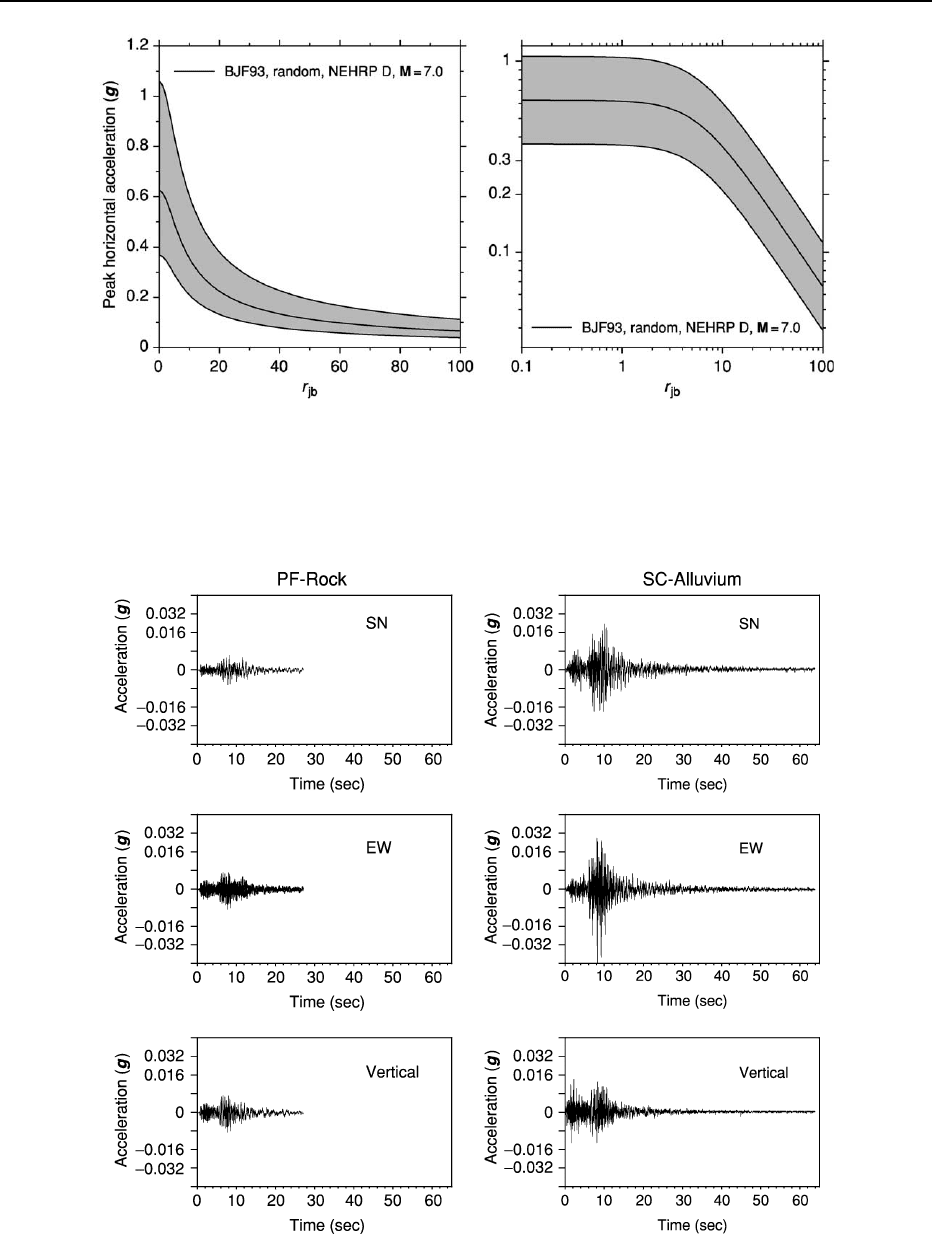
Figure 12 Predicted values of horizontal peak ground acceleration on soft soil (National Earthquake Hazards Reduction Program
(NEHRP) class D) sites for an earthquake of magnitude 7 as a function of distance from the surface projection of the fault rupture (r
jb
).
The predictions are made using an equation derived from earthquakes recorded in western North America, by DM Boore, WB Joyner,
and TE Fumal. The thick black line of Boore, Joyner, and Fumal (BJF93) shows the median predicted values and the grey bands
indicate the range of the median multiplied and divided by 10
s
, where s is the standard deviation of the logarithmic residual; on
average, 68% of observations would be expected to fall within the grey area.
Figure 13 Accelerograms recorded on two instruments in the Gemona (Italy) array during the M 5.6 Bovak (Slovenia) earthquake of
12 April 1998 (M ¼ moment magnitude). Both instruments are 38 km from the earthquake epicentre, and are separated by about 700 m.
The Piazza del Ferro station (PF) is on rock with a shear-wave velocity reported as 2500 m s
1
, whereas the Scugelars station (SC) is on
alluvium with a shear-wave velocity of 500 m s
1
. Because the distance and azimuth of the two stations with respect to the earthquake
source are almost identical, the difference between the amplitude of the two recordings is primarily due to the different surface geology
at the two recording locations (SN, south–north; EW, east–west).
ENGINEERING GEOLOGY/Seismology 509
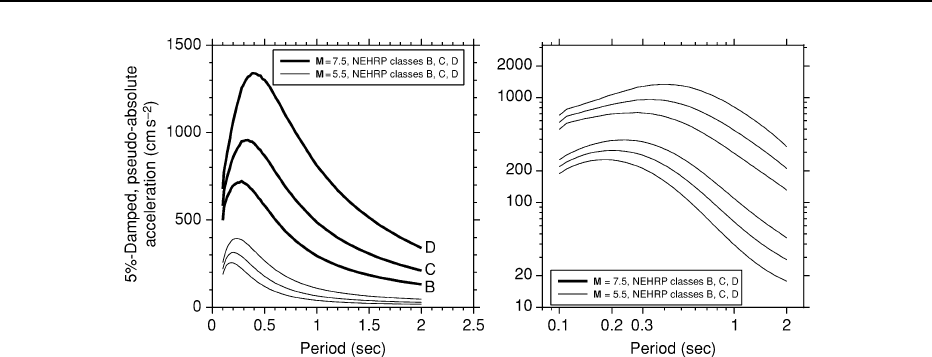
other regions, the number of available accelerograms
is further reduced by the relatively low frequency of
felt earthquakes. Seismic hazard assessment in such
regions is hampered by the absence of indigenous
recordings, and a solution that is often employed is
to use stochastic simulations to generate motions
based on representing the ground shaking as random
motion with frequency content and duration that are
controlled by theoretical and empirical descriptions
of seismic radiation and propagation (Figure 17).
Complete acceleration time-histories can also be
generated using more sophisticated seismological
models that represent the source as a finite fault rup-
ture. These simulations usually take the form of a
kinematic model of the fault rupture, with rupture
velocities and slip amplitudes specified across the
fault plane (although these can be specified using
statistical distribution in order to be able to generate
a suite of motions for a given rupture). Dynamic fault
modelling, in which the stress conditions are specified
and subsequent rupture is controlled by friction laws
on the fault surface as well as the heterogeneous three-
dimensional stress distribution, is less commonly used
for the simulation of ground motions for engineering
purposes because the necessary physical quantities
are not known with sufficient precision and because
the computational effort is much greater than with
the kinematic models (which can be quite demand-
ing if lateral variations in geology are taken into
account). In the future, as computers become more
powerful and the details of the geologic structure
and velocity distributions are better determined, it is
likely that the kinematic models will continue to be
used, but the simulations will better represent the
effects of wave propagation.
Seismic Hazard Assessment
Engineering seismology is often described as the link
between Earth sciences and engineering, and this is
most evident in seismic hazard assessment, the aim of
which is to estimate the earthquake ground motions
that can be expected at a particular location. Seismic
hazard assessments may be performed for a number
of reasons, the most common being to determine
seismic loads to be considered in earthquake-resistant
design of buildings. Another common application is
the evaluation of the ground motions required as
input to the assessment of landslide or liquefaction
hazard. A rapidly expanding market for seismic hazard
assessments is being created by the demand for earth-
quake loss models by local governments, emergency
services, seismic code developers, and particularly the
insurance and reinsurance industries.
There are many different ways to approach seismic
hazard assessment, but all methods and approaches
include two essential elements: a model for earth-
quake occurrence and a model for predicting ground
motions from each earthquake. The starting point for
building a model for earthquake occurrence, known
as a seismicity model, is to first identify the locations
where earthquakes will be expected to occur in the
future. Data used to define seismic source zones in-
clude previous earthquake activity, the existence of
geological faults, and crustal deformations. Ideally,
all seismic sources should be identified as active geo-
logical faults, but this is very often not possible, hence
zones are defined as areas within which future earth-
quakes are expected to occur (Figure 18). Some recent
approaches to seismic hazard assessment dispense
with source zones altogether, basing the sources of
Figure 14 Predicted median ordinates of spectral acceleration (5% damped) for earthquakes of magnitudes 5.5 and 7.5, recorded at
10 km on sites classified as B, C, and D in the National Earthquake Hazards Reduction Program (NEHRP) scheme, corresponding to
soft rock, stiff soil, and soft soil, respectively. The two graphs are identical except for the left-hand plot being on linear axes and the
right-hand plot being on logarithmic axes.
510 ENGINEERING GEOLOGY/Seismology
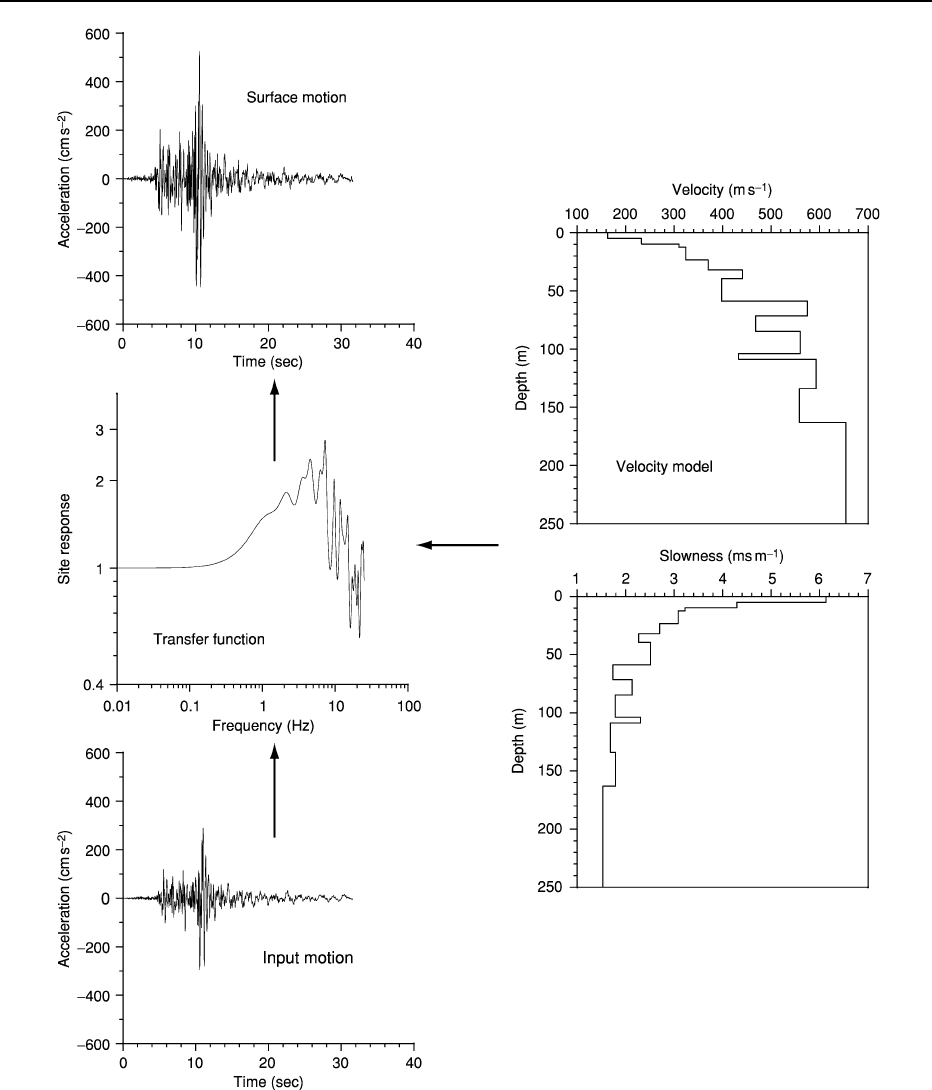
Figure 15 Illustration of site response analysis: The input motion in the underlying rock (bottom left) passes through a model of soil
profile to produce the surface motions (top left). The soil characteristics are represented either by the shear-wave velocity or the
shear-wave slowness (right); the slowness is simply the reciprocal of the shear-wave velocity, but there are many reasons for using it
in place of the velocity. The theoretical response of layered systems involves travel times across the layers, which are directly
proportional to the slowness; the proportionality to velocity is inverse. Furthermore, to obtain a representative profile for a soil
class using several boreholes, individual measures of slowness can be directly averaged, whereas it is not correct to do this for
velocities. Finally, the largest influence on the surface motion is due to the differences in velocities near the surface, and these
differences become more clearly apparent when the slowness profile is shown; larger velocity differences in the stiffer layers at
greater depths, which can dominate a velocity profile, are less important.
ENGINEERING GEOLOGY/Seismology 511
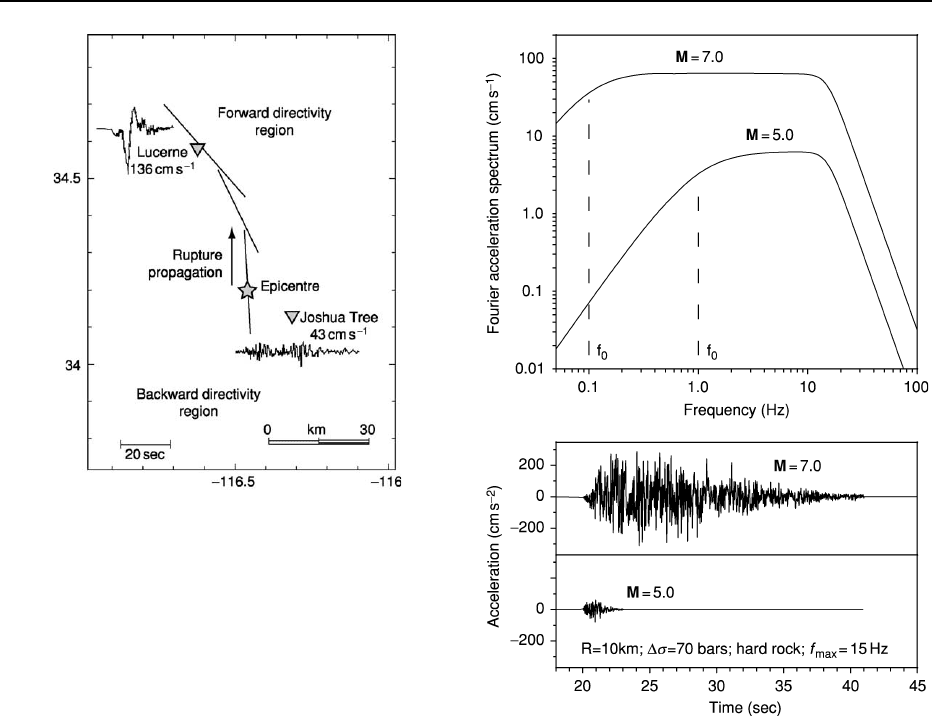
postulated future events on past activity. The cata-
logue of instrumentally recorded earthquakes extends
back at the very most to 1898, which is a very short
period of observation for events for which recurrence
intervals can extend to hundreds or even thousands of
years. For this reason, great value is to be obtained
from extending the catalogue through the careful
interpretation of historical records, making use of
empirical relationships between magnitude and inten-
sity referred to previously. The seismic record can also
be extended through palaeoseismology, by quantify-
ing and dating coseismic displacements on geological
faults.
Although the distinction masks many equally
marked differences among the various methods that
fall within each camp, a basic division exists between
deterministic and probabilistic approaches to seismic
hazard assessment. In the deterministic approach,
only a few earthquake scenarios are considered, and
sometimes just one is selected to represent an ap-
proximation to the worst case. The controlling earth-
quake will generally correspond to an event with the
nominal maximum credible magnitude, located at the
location closest to the site within the seismogenic
source; the ground motion is generally calculated as
the 50- or 84-percentile value from the prediction
equation. In the probabilistic approach, all possible
earthquake scenarios are considered, including
events of every magnitude, from the minimum con-
sidered to be of engineering significance (4) up to
the maximum credible, occurring at every possible
location within the source zones, and for each magni-
tude–distance combination various percentiles of
the motion are considered to reflect the scatter in
the ground-motion prediction equations. Alternative
options for the input parameters may be considered
by using a logic-tree formulation, in which weights
are assigned to different options that reflect the
Figure 16 Velocity time-series obtained from integration of
horizontal accelerograms recorded at Lucerne and Joshua Tree
stations during the 1992 Landers earthquake in California. The
fault rupture propagated towards Lucerne and away from Joshua
Tree, creating forward directivity effects (short-duration shaking
consisting of a concentrated high-energy pulse of motion) at the
former, and backward directivity effects (long-duration shaking of
several small pulses of motion) at the latter. Reprinted with
permission from: Somerville PG, Smith NF, Graves RW, and
Abrahamson NA (1997) Modification of empirical strong ground
motion attenuation relations to include the amplitude and dur-
ation effects of rupture directivity.
Seismological Research Letters
68(1): 199–222. ß Seismological Society of America.
Figure 17 Theoretical Fourier spectra for earthquakes of mag-
nitudes 5 and 7 at 10 km from a rock site, assuming a stress
parameter of 70 bars; f
0
is the corner frequency, which is inversely
proportional to the duration of rupture. The lower part of the figure
shows stochastic acceleration time-series generated from these
spectra, from which the influence of magnitude on amplitude and
duration (or number of cycles) can be clearly observed. From
the spectra in the upper part of the figure, it can be appreciated
that scaling with magnitude is frequency-dependent, with larger
magnitude events generating proportionally more long-period
radiation.
512 ENGINEERING GEOLOGY/Seismology

relative confidence in their being the best representa-
tion (Figure 19). The output is a ranking of these
earthquake scenarios in terms of the ground-motion
amplitudes that they generate at the site and their
frequency of occurrence (Figure 20).
Seismic hazard assessment can be carried out for
an individual site, the output including a response
spectrum calculated ordinate by ordinate, or even a
suite of accelerograms. Hazard assessment is often
performed for regions or countries, deriving hazard
curves for a large number of locations and then
drawing contours of a ground-motion parameter
(most often PGA) for a given annual frequency of
occurrence, which is often expressed in terms of
its inverse, known as a return period (Figure 21).
Such hazard maps in terms of PGA are the basis of
Figure 18 Seismic sources used for probabilistic hazard study
of the Mississippi embayment. Small squares show the epicen-
tres of earthquakes with the size corresponding to the body-wave
magnitude M
b
. (A) The New Madrid seismic source zone repre-
sented as a number of parallel hypothetical faults; (B) the area
sources used to represent seismicity not associated with the
New Madrid zone. Reprinted with permission from Toro GR,
Silva WJ, McGuire RK, and Herrmann RB (1992) Probabilistic
seismic hazard assessment of the Mississippi Embayment.
Seis-
mological Research Letters
63(3): 449–475. ß Seismological Society
of America.
Figure 19 Logic-tree formulation for probabilistic seismic
hazard study of the Mississippi embayment. For different input
parameters, different options are considered at each node, which
are then assigned weights (
p) to reflect the relative confidence in
each option; the values of p at each node always sum to unity. The
source geometry options are the faults shown in Figure 18, and
an alternative model in which the faults are longer. Reprinted
with permission from Toro GR, Silva WJ, McGuire RK, and
Herrmann RB (1992) Probabilistic seismic hazard assessment
of the Mississippi Embayment.
Seismological Research Letters
63(3): 449–475. ß Seismological Society of America.
Figure 20 Seismic summary hazard curves for spectral accel-
eration at 1-s response period for Memphis (including site re-
sponse), obtained using the logic-tree formulation in Figure 19.
Reprinted with permission from Toro GR, Silva WJ, McGuire RK,
and Herrmann RB (1992) Probabilistic seismic hazard assess-
ment of the Mississippi Embayment.
Seismological Research Letters
63(3): 449-475. ß Seismological Society of America.
ENGINEERING GEOLOGY/Seismology 513
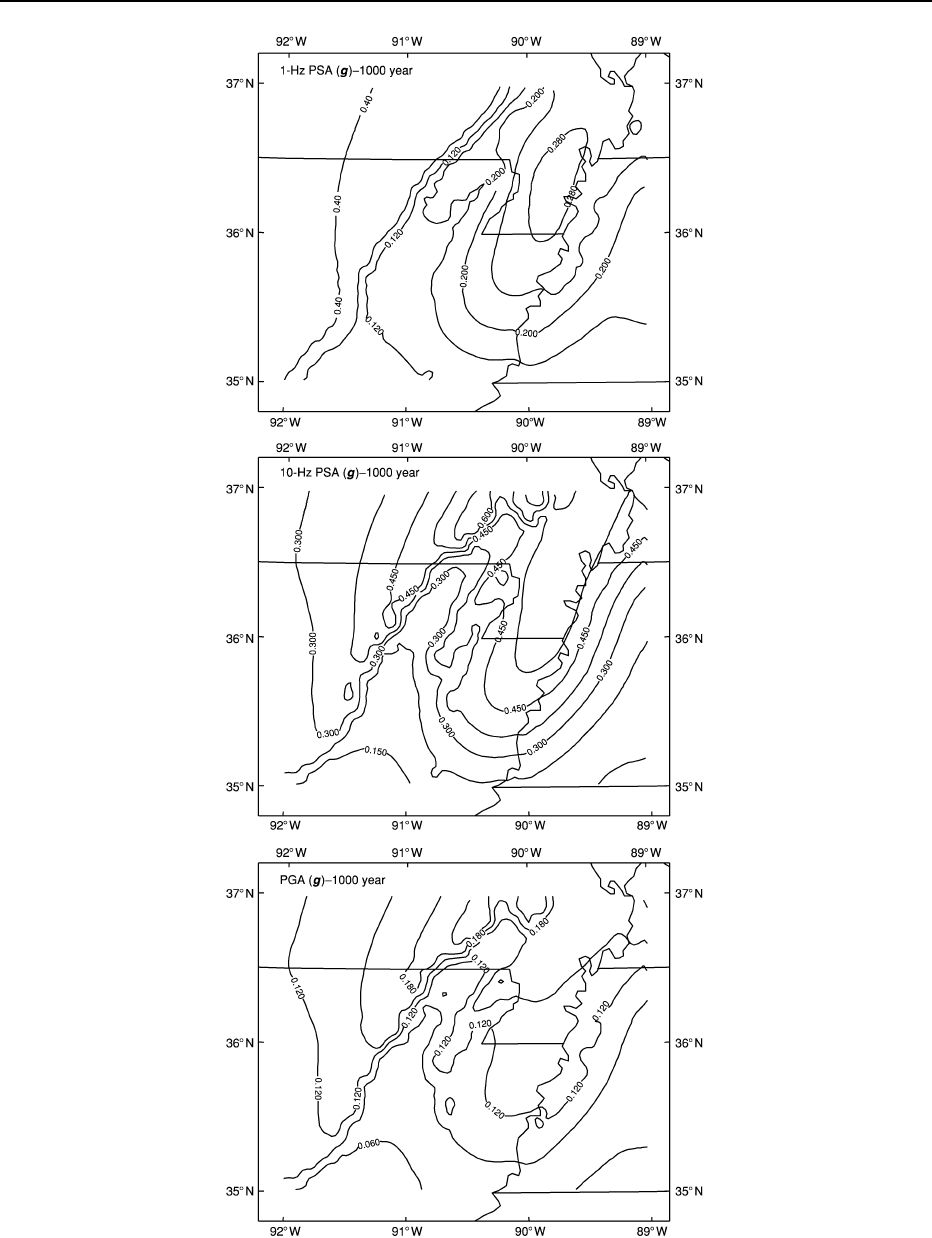
Figure 21 Contours of spectral accelerations in the Mississippi embayment with a 1000-year return period, for different response
frequencies corresponding to the response periods of 1.0s (top) and 0.1s (middle) and to PGA (botom). The maps show the spectral
accelerations read from the mean hazard curve. Reprinted with permission from Toro GR, Silva WJ, McGuire RK, and Herrmann RB
(1992) Probabilistic seismic hazard assessment of the Mississippi Embayment.
Seismological Research Letters 63(3): 449–475. ß
Seismological Society of America.
514 ENGINEERING GEOLOGY/Seismology

zonation maps included in seismic design codes, from
which design response spectra are constructed by
anchoring a spectral shape selected for the appropri-
ate site class to the PGA value read from the zonation
map.
See Also
Engineering Geology: Aspects of Earthquakes; Nat-
ural and Anthropogenic Geohazards; Liquefaction.
Sedimentary Processes: Particle-Driven Subaqueous
Gravity Processes. Tectonics: Earthquakes; Faults;
Neotectonics.
Further Reading
Abrahamson NA (2000) State of the Practice of Seismic
Hazard Evaluation. GeoEng 2000,19–24 November,
Melbourne, Australia.
Ambraseys NN (1988) Engineering seismology. Earthquake
Engineering & Structural Dynamics 17: 1–105.
Beskos DE and Anagnostopoulos SA (1997) Computer An-
alysis and Design of Earthquake Resistant Structures:
A Handbook, chs 3–5. Southampton: Computational
Mechanics Publications.
Bommer JJ (2003) Uncertainty about the uncertainty in seis-
mic hazard analysis. Engineering Geology 70: 165–168.
Boore DM (1977) The motion of the ground in earth-
quakes. Scientific American 237: 68–78.
Boore DM (2003) Simulation of ground motion using the
stochastic method. Pure and Applied Geophysics 160:
635–676.
Chen W-F and Scawthorn C (2003) Earthquake Engineer-
ing Handbook, chs 1–10. Boca Raton, FL: CRC Press.
Douglas J (2003) Earthquake ground motion estimation
using strong-motion records: a review of equations for
the estimation of peak ground acceleration and response
spectral ordinates. Earth Science Reviews 61: 43–104.
Dowrick D (2003) Earthquake Risk Reduction. Chichester,
England: John Wiley.
Giardini D (1999) The global seismic hazard assessment
program (GSHAP) 1992–1999: summary volume. Annali
di Geofisica 42(6): 957–1230.
Giardini D and Basham P (1993) Technical planning
volume of the ILP’s global seismic hazard assessment
program for the UN/IDNDR. Annali di Geofisica
36(3/4): 3–257.
Hudson DL (1979) Reading and Interpreting Strong
Motion Accelerograms. EERI Monograph, Earthquake
Engineering Research Institute, Oakland, California.
Jackson JA (2001) Living with earthquakes: know your
faults. Journal of Earthquake Engineering 5(special
issue 1): 5–123.
Kramer SL (1996) Geotechnical Earthquake Engineering.
Upper Saddle River, NJ: Prentice-Hall.
Lee WHK, Kanamori H, Jennings PC, and Kisslinger C
(2003) International Handbook of Earthquake and
Engineering Seismology, Part B. chs. 57–64. Amsterdam:
Academic Press.
McGuire RK (2004) Seismic Hazard and Risk Analysis.
EERI Monograph MNO-10. Earthquake Engineering
Research Institute, Oakland, California.
Naeim F (2001) The Seismic Design Handbook, 2nd edn.
chs. 1–3. Boston: Kluwer Academic Publ.
Reiter L (1990) Earthquake Hazard Analysis: Issues and
Insights. New York: Columbia University Press.
Natural and Anthropogenic Geohazards
G J H McCall, Cirencester, Gloucester, UK
ß 2005, Elsevier Ltd. All Rights Reserved.
Introduction
The topic of geohazards became popular with scien-
tists and the media in the early 1990s at the time of the
International Decade for Natural Disaster Reduction
aimed, by the United Nations, specifically at develop-
ing nations in the Third World. It became popular
with the media in the belief that we were moving
into an age of disaster. In particular, the appreciation
of the reality of global climate change and human-
kind’s contribution in the Industrial Age to global
warming has led to an awareness of the vulnerability
of the world in which we live. Geohazards operate
at local scales, e.g., in villages and towns, at a regional
scale, and at the largest scale of all, global. Urban
geohazards represent a specialized and increasingly
important type of hazard.
An increasing incidence and scale of risk and
disaster have recently occurred due to a number of
factors:
.
increased population concentrations;
.
increased technological development;
.
over-intensive agriculture and increased industrial-
ization;
.
excessive use of the internal combustion engine and
other noxious fume emitters, and wasteful trans-
port systems;
.
poor technological practices in construction, water
management, and waste disposal;
.
excessive emphasis on commercial development;
.
increased scientific tinkering with Nature without
due concern for long-term effects.
ENGINEERING GEOLOGY/Natural and Anthropogenic Geohazards 515
